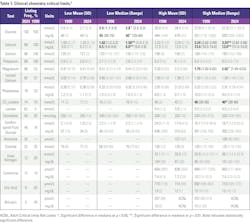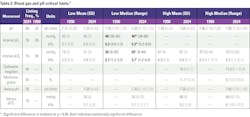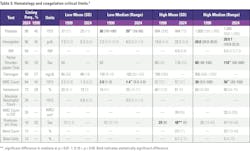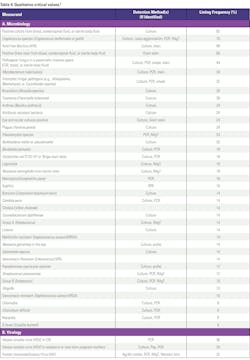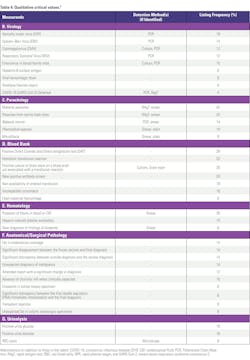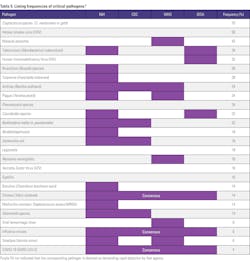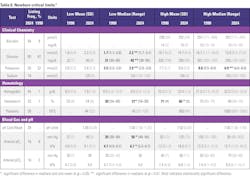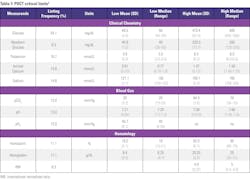To download the Table of Critical Limits, click here.
Critical limits define the quantitative boundaries of life-threatening diagnostic test results. Critical results falling outside high and low critical limits must be reported to clinicians urgently, so the patient can be treated promptly if necessary. Critical value reporting was implemented by George Lundberg, MD, and published in MLO in 1972.1 Analysis of the impact of critical notifications on patient outcomes appeared in MLO in 1993 with follow-up articles calling for national harmonization and standards of care for critical notification practices.2-4
These tables reflect research published in 2025 by Gerald Kost, MD, PhD, MS, FADLM of the POCT•CTR, School of Medicine, UC Davis, and his UC Honors Program student team. The research entailed a review of 50 critical limits/values lists from university hospitals, Level 1 trauma centers, centers of excellence, and high-performing hospitals across the U.S.5 with comparison to 1990-93 data compiled through the first three national surveys of critical limits used by 92 responding U.S. medical centers, including 20 trauma centers and 39 children’s hospitals.6-8 Most hospital policies posted on the Web defined what a critical value is and stated that a licensed provider must be informed immediately.9
Statistically significant differences in 2024 versus 1990-93 critical limits were observed for glucose, calcium, magnesium, CO2 content, blood gas parameters, hematology, and coagulation tests. Ranges for critical limits narrowed for several tests, and new measurands were added. Point-of-care testing (POCT) listings were scarce and revealed notable differences from main lab values in the high median critical limit for glucose.5
The Joint Commission identifies timely reporting of critical tests results as a National Patient Safety Goal (NPSG.02.03.01) in its accreditation programs.10 Clinical laboratories can develop notification practices collaboratively with emergency physicians, hospitalists, and point-of-care specialists to achieve timely, effective, and focused patient care. For example, the statistically significant increase in the low critical limit for glucose, which increases the notification frequency, may reflect recognition of the level two threshold [54 mg/dL (3.0 mmol/L)] at which neuroglycopenic symptoms require immediate action.11
Hospitals are advised to review their notification practices, quantitative decision thresholds, and qualitative critical value notifications to assure that effective life-saving alerts improve patient outcomes without excessively burdening laboratory, bedside, critical care, or emergency staff.
References
- Lundberg GD. When to panic over an abnormal value. MLO. 1972;4:47-54.
- Kost GJ. Using critical limits to improve patient outcomes. MLO. 1993;25(3):22-27.
- Kost GJ. Co-creating critical limits for enhanced acute care: proven need and web knowledge base. Part 1: A call to action! MLO. 2015;47(12):34, 36-37.
- Kost GJ. Co-creating critical limits for enhanced acute care: proven need and web knowledge base. Part 2: Standard of care, what it means and how it is applied. MLO. 2016;48(1):28-29.
- Shah A, Dohner J, Cheng K, Garcia M, Kost GJ. Visualization of Critical Limits and Critical Values Facilitates Interpretation. Diagnostics (Basel). 2025;15(5):604. doi:10.3390/diagnostics15050604.
- Kost GJ. Critical limits for urgent clinician notification at U.S. medical centers. JAMA. 1990;263:704-707.
- Kost GJ. Critical limits for emergency clinician notification at U.S. children’s hospitals. Pediatrics. 1991;88:597-603.
- Kost GJ. The significance of ionized calcium in cardiac and critical care. Availability and critical limits at U.S. medical centers and children’s hospitals. Arch Pathol Lab Med. 1993;117:890-896.
- Kost GJ, Dohner J, Liu J, Ramos D, Haider N, Thalladi V. Web-accessible critical limits and critical values for urgent clinician notification. Clin Chem Lab Med. 2024;1-13. doi:10.1515/cclm-2024-0117.
- Joint Commission. National Patient Safety Goal 02.03.01. Effective January 2025. https://www.jointcommission.org/-/media/tjc/documents/standards/ national-patient-safety-goals/2025/lab-npsg-chapter-2025.pdf. Accessed May 9, 2025.
- American Diabetes Association. Glycemic targets: Standards of medical care in diabetes—2019. Diabetes Care. 2019;42(S1):S61-S70.
